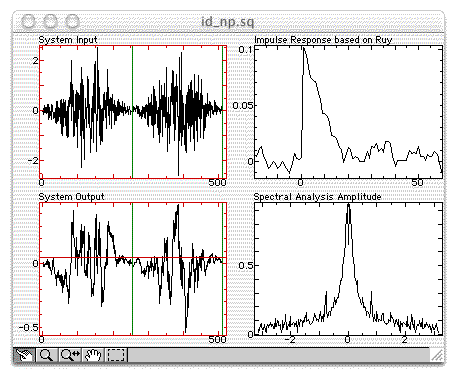Sysquake Pro – Table of Contents
Sysquake for LaTeX – Table of Contents
id_np.sq
Non-parametric identification

First contact
SQ file id_np.sq provides the identification methods to obtain a non-parametric
model based on the measured input and output of an unknown system
For didactic purposes, synthetic data can be created for input
Time-domain identification with correlation analysis
The covariance of the input
Frequency-domain identification with spectral analysis
The spectrum of the system can be approximated either by dividing the output's
discrete Fourier transform (FFT) by the input's, or (better if the output is
disturbed by noise) by dividing
Remark: the splitting in n sequences is used only by the spectral analysis. The time window is used for all frequency-domain analysis methods, while the whitening filter is used only for correlation analysis.
Settings
System
The system used to create synthetic sampled data is given as the
numerator and denominator of a discrete-time transfer function in positive
powers of
Number of samples
Total number of samples which should be created.
White Noise or Pseudo-Random Binary Sequence
For synthetic data, the system input can be chosen among white noise, where each sample is the result of a normally distributed pseudo-random generator, or a pseudo-random binary sequence where the probability to switch the level at each sample is 50%, 20% or 5%. With 20% or 5%, the signal is significantly different from white noise.
Whitening Filter
For the correlation analysis, a whitening filter should be used if the system input is significantly different from white noise. The whitening filter is a finite-impulse response (FIR) filter whose inverse is the auto-regressive (AR) model which gives the non-white input. The whitening filter is not used for frequency-domain identification.
Rectangular/Triangular/Hann/Hamming Window
To reduce the effect of the finite number of samples (aliasing), a non-rectangular window can be applied to the input and output samples. The Hann and Hamming windows have a sinusoidal shape. The windows are not used for time-domain identification.
Multiple Sequences
For frequency-domain identification, it may be better to split the available data and use the different sequences to reduce the variance of the estimation. The price to pay is the lower resolution of the estimate. The number of sequences is set by moving the green vertical lines in the input or output figure.
Read Data File
The measurements are read from a text file, typically created by an acquisition program. This file should contain an array of two column (separated by spaces or tabulators) by n row (separated by carriage returns and/or line feeds). The first column corresponds to the system input, and the second column to the system output. Each row corresponds to a sample.